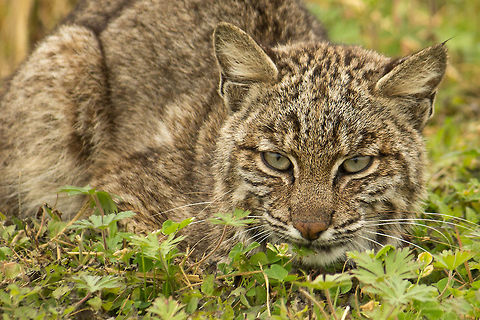
Appearance
The bobcat resembles other species of the midsize genus "Lynx", but is on average the smallest of the four. Its coat is variable, though generally tan to grayish-brown, with black streaks on the body and dark bars on the forelegs and tail. Its spotted patterning acts as camouflage. The ears are black-tipped and pointed, with short, black tufts. Generally, an off-white color is seen on the lips, chin, and underparts. Bobcats in the desert regions of the southwest have the lightest-colored coats, while those in the northern, forested regions are darkest. Kittens are born well-furred and already have their spots. A few melanistic bobcats have been sighted and captured in Florida. They appear black, but may still exhibit a spot pattern.The face appears wide due to ruffs of extended hair beneath the ears. Bobcat eyes are yellow with round, black pupils. The nose of the bobcat is pinkish-red, and it has a base color of gray or yellowish- or brownish-red on its face, sides, and back. The pupils are round, black circles and will widen during nocturnal activity to maximize light reception. The cat has sharp hearing and vision, and a good sense of smell. It is an excellent climber, and swims when it needs to, but normally avoids water. However, cases of bobcats swimming long distances across lakes have been recorded.
The adult bobcat is 47.5 to 125 cm long from the head to the base of its distinctive stubby tail, averaging 82.7 cm; the tail, which appears “bobbed” and gives the species its name, adds 9 to 20 cm
An adult stands about 30 to 60 cm at the shoulders. Adult males can range in weight from 6.4 to 18.3 kg, with an average of 9.6 kg; females at 4 to 15.3 kg, with an average of 6.8 kg. The largest bobcat accurately measured on record weighed 22.2 kg, although unverified reports have them reaching 27 kg. Furthermore, a June 20, 2012 report of a New Hampshire roadkill specimen listed the animal's weight at 27 kg. The largest-bodied bobcats are from eastern Canada and northern New England of the subspecies "L. r. gigas", while the smallest are from the southeastern subspecies "L. r. floridanus", particularly those in the southern Appalachians. The bobcat is muscular, and its hind legs are longer than its front legs, giving it a somewhat irregular gait. At birth, it weighs 0.6 to 0.75 lb and is about 10 in in length. By its first birthday, it weighs about 10 lb.
The cat is larger in its northern range and in open habitats. A morphological size comparison study in the eastern United States found a divergence in the location of the largest male and female specimens, suggesting differing selection constraints for the sexes.
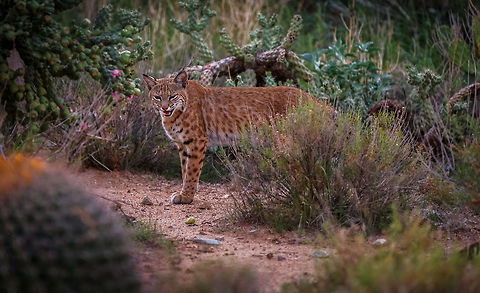
Naming
13 bobcat subspecies have been historically recognized based on morphological characteristics:⤷ "L. r. rufus" – eastern and midwestern United States
⤷ "L. r. gigas" – northern New York to Nova Scotia and New Brunswick
⤷ "L. r. floridanus" – southeastern United States and inland to the Mississippi Valley, up to southwestern Missouri and southern Illinois
⤷ "L. r. superiorensis" – western Great Lakes area, including upper Michigan, Wisconsin, southern Ontario, and most of Minnesota
⤷ "L. r. baileyi" – southwestern United States and northwestern Mexico
⤷ "L. r. californicus" – California west of the Sierra Nevada
⤷ "L. r. mohavensis" – Mojave Desert of California
⤷ "L. r. escuinapae" – central Mexico, with a northern extension along the west coast to southern Sonora
⤷ "L. r. fasciatus" – Oregon, Washington west of the Cascade Range, northwestern California, and southwestern British Columbia
⤷ "L. r. oaxacensis" – Oaxaca
⤷ "L. r. pallescens" – northwestern United States and southern British Columbia, Alberta, and Saskatchewan
⤷ "L. r. peninsularis" – Baja California
⤷ "L. r. texensis" – western Louisiana, Texas, south-central Oklahoma, and south into Tamaulipas, Nuevo León, and Coahuila
This subspecies division has been challenged, given a lack of clear geographic breaks in their ranges and the minor differences between these subspecies. The latest revision of cat taxonomy in 2017, by the Cat Classification Taskforce of the Cat Specialist Group recognises only two subspecies, based on phylogeographic and genetic studies, although the status of the Mexican bobcat remains under review:
⤷ "Lynx rufus rufus" – east of the Great Plains, North America
⤷ "Lynx rufus fasciatus" – west of the Great Plains, North America
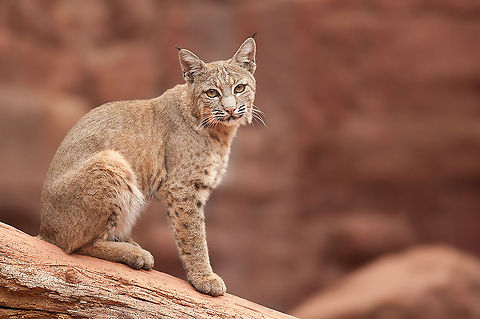
Distribution
The bobcat is an adaptable animal. It prefers woodlands—deciduous, coniferous, or mixed—but unlike the other "Lynx" species, it does not depend exclusively on the deep forest. It ranges from the humid swamps of Florida to desert lands of Texas or rugged mountain areas. It makes its home near agricultural areas, if rocky ledges, swamps, or forested tracts are present; its spotted coat serves as camouflage. The population of the bobcat depends primarily on the population of its prey; other principal factors in the selection of habitat type include protection from severe weather, availability of resting and den sites, dense cover for hunting and escape, and freedom from disturbance.The bobcat's range does not seem to be limited by human populations, as long as it can find a suitable habitat; only large, intensively cultivated tracts are unsuitable for the species. The animal may appear in back yards in "urban edge" environments, where human development intersects with natural habitats. If chased by a dog, it usually climbs up a tree.
The historical range of the bobcat was from southern Canada, throughout the United States, and as far south as the Mexican state of Oaxaca, and it still persists across much of this area. In the 20th century, it was thought to have lost territory in the US Midwest and parts of the Northeast, including southern Minnesota, eastern South Dakota, and much of Missouri, mostly due to habitat changes from modern agricultural practices. While thought to no longer exist in western New York and Pennsylvania, multiple confirmed sightings of bobcats have been recently reported in New York's Southern Tier and in central New York, and a bobcat was captured in 2018 on a tourist boat in Downtown Pittsburgh, Pennsylvania. In addition, bobcat sightings have been confirmed in northern Indiana, and one was recently killed near Albion, Michigan. In early March 2010, a bobcat was sighted in a parking garage in downtown Houston. By 2010, bobcats appear to have recolonized many states, occurring in every state except Delaware.
Its population in Canada is limited due to both snow depth and the presence of the Canadian lynx. The bobcat does not tolerate deep snow, and waits out heavy storms in sheltered areas; it lacks the large, padded feet of the Canadian lynx and cannot support its weight on snow as efficiently. The bobcat is not entirely at a disadvantage where its range meets that of the larger felid: displacement of the Canadian lynx by the aggressive bobcat has been observed where they interact in Nova Scotia, while the clearing of coniferous forests for agriculture has led to a northward retreat of the Canadian lynx's range to the advantage of the bobcat. In northern and central Mexico, the cat is found in dry scrubland and forests of pine and oak; its range ends at the tropical southern portion of the country.
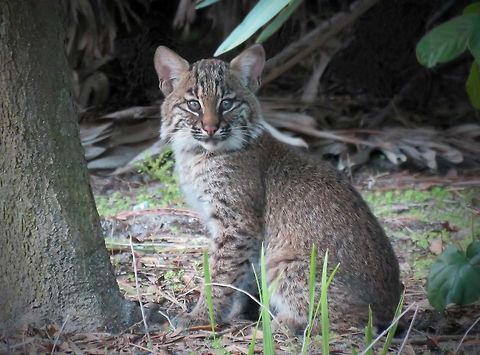
Behavior
The bobcat is crepuscular, and is active mostly during twilight. It keeps on the move from three hours before sunset until about midnight, and then again from before dawn until three hours after sunrise. Each night, it moves from 2 to 7 mi along its habitual route. This behavior may vary seasonally, as bobcats become more diurnal during fall and winter in response to the activity of their prey, which are more active during the day in colder weather.Bobcat activities are confined to well-defined territories, which vary in size depending on the sex and the distribution of prey. The home range is marked with feces, urine scent, and by clawing prominent trees in the area. In its territory, the bobcat has numerous places of shelter, usually a main den, and several auxiliary shelters on the outer extent of its range, such as hollow logs, brush piles, thickets, or under rock ledges. Its den smells strongly of the bobcat.The sizes of bobcats' home ranges vary significantly; a World Conservation Union summary of research suggests ranges from 0.23 to 126 sq mi. One study in Kansas found resident males to have ranges of roughly 8 sq mi, and females less than half that area. Transient bobcats were found to have both larger ) and less well-defined home ranges. Kittens had the smallest range at about 3 sq mi. Dispersal from the natal range is most pronounced with males.
Reports on seasonal variation in range size have been equivocal. One study found a large variation in male range sizes, from 16 sq mi in summer up to 40 sq mi in winter. Another found that female bobcats, especially those which were reproductively active, expanded their home range in winter, but that males merely shifted their range without expanding it, which was consistent with numerous earlier studies. Other research in various American states has shown little or no seasonal variation.
Like most felines, the bobcat is largely solitary, but ranges often overlap. Unusual for cats, males are more tolerant of overlap, while females rarely wander into others' ranges. Given their smaller range sizes, two or more females may reside within a male's home range. When multiple territories overlap, a dominance hierarchy is often established, resulting in the exclusion of some transients from favored areas.
In line with widely differing estimates of home range size, population density figures are divergent, from one to 38 bobcats per 10 sq mi in one survey. The average is estimated at one bobcat per 5 square miles. A link has been observed between population density and sex ratio. One study noted a dense, unhunted population in California had a sex ratio of 2.1 males per female. When the density decreased, the sex ratio skewed to 0.86 males per female. Another study observed a similar ratio, and suggested the males may be better able to cope with the increased competition, and this helped limit reproduction until various factors lowered the density.The average bobcat lifespan is 7 years long and rarely exceeds 10 years. The oldest wild bobcat on record was 16 years old, and the oldest captive bobcat lived to be 32.
Bobcats generally begin breeding by their second summer, though females may start as early as their first year. Sperm production begins each year by September or October, and the male is fertile into the summer. A dominant male travels with a female and mates with her several times, generally from winter until early spring; this varies by location, but most mating takes place during February and March. The pair may undertake a number of different behaviors, including bumping, chasing, and ambushing. Other males may be in attendance, but remain uninvolved. Once the male recognizes the female is receptive, he grasps her in the typical felid neck grip and mates with her. The female may later go on to mate with other males, and males generally mate with several females. During courtship, the otherwise silent bobcat may let out loud screams, hisses, or other sounds. Research in Texas has suggested establishing a home range is necessary for breeding; studied animals with no set range had no identified offspring. The female has an estrous cycle of 44 days, with the estrus lasting five to ten days. Bobcats remain reproductively active throughout their lives.
The female raises the young alone. One to six, but usually two to four, kittens are born in April or May, after roughly 60 to 70 days of gestation. Sometimes, a second litter is born as late as September. The female generally gives birth in an enclosed space, usually a small cave or hollow log. The young open their eyes by the ninth or tenth day. They start exploring their surroundings at four weeks and are weaned at about two months. Within three to five months, they begin to travel with their mother. They hunt by themselves by fall of their first year, and usually disperse shortly thereafter. In Michigan, however, they have been observed staying with their mother as late as the next spring.

Habitat
The adult bobcat has relatively few predators other than humans. However seldomly, it may be killed in interspecific conflict by several larger predators or fall prey to them. Cougars and gray wolves can kill adult bobcats, a behavior repeatedly observed in Yellowstone National Park as well as elsewhere. Coyotes have killed adult bobcats and kittens. At least one confirmed observation of a bobcat and an American black bear " fighting over a carcass is confirmed. Like other "Lynx" species, bobcats probably avoid encounters with bears, in part because they are likely to lose kills to them or may be rarely be attacked by them. Bobcat remains have occasionally been found in the resting sites of male fishers. American alligators have been filmed opportunistically preying on adult bobcats in the southeast United States.Kittens may be taken by several predators, including owls, eagles, foxes, and bears, as well as other adult male bobcats; when prey populations are not abundant, fewer kittens are likely to reach adulthood. Golden eagles have been reportedly observed preying on bobcats.
Diseases, accidents, hunters, automobiles, and starvation are the other leading causes of death. Juveniles show high mortality shortly after leaving their mothers, while still perfecting their hunting techniques. One study of 15 bobcats showed yearly survival rates for both sexes averaged 0.62, in line with other research suggesting rates of 0.56 to 0.67. Cannibalism has been reported; kittens may be taken when prey levels are low, but this is very rare and does not much influence the population.
The bobcat may have external parasites, mostly ticks and fleas, and often carries the parasites of its prey, especially those of rabbits and squirrels. Internal parasites are especially common in bobcats. One study found an average infection rate of 52% from "Toxoplasma gondii", but with great regional variation. One mite in particular, "Lynxacarus morlani", has to date been found only on the bobcat. Parasites' and diseases' role in the mortality of the bobcat is still unclear, but they may account for greater mortality than starvation, accidents, and predation.The bobcat is an adaptable animal. It prefers woodlands—deciduous, coniferous, or mixed—but unlike the other "Lynx" species, it does not depend exclusively on the deep forest. It ranges from the humid swamps of Florida to desert lands of Texas or rugged mountain areas. It makes its home near agricultural areas, if rocky ledges, swamps, or forested tracts are present; its spotted coat serves as camouflage. The population of the bobcat depends primarily on the population of its prey; other principal factors in the selection of habitat type include protection from severe weather, availability of resting and den sites, dense cover for hunting and escape, and freedom from disturbance.
The bobcat's range does not seem to be limited by human populations, as long as it can find a suitable habitat; only large, intensively cultivated tracts are unsuitable for the species. The animal may appear in back yards in "urban edge" environments, where human development intersects with natural habitats. If chased by a dog, it usually climbs up a tree.
The historical range of the bobcat was from southern Canada, throughout the United States, and as far south as the Mexican state of Oaxaca, and it still persists across much of this area. In the 20th century, it was thought to have lost territory in the US Midwest and parts of the Northeast, including southern Minnesota, eastern South Dakota, and much of Missouri, mostly due to habitat changes from modern agricultural practices. While thought to no longer exist in western New York and Pennsylvania, multiple confirmed sightings of bobcats have been recently reported in New York's Southern Tier and in central New York, and a bobcat was captured in 2018 on a tourist boat in Downtown Pittsburgh, Pennsylvania. In addition, bobcat sightings have been confirmed in northern Indiana, and one was recently killed near Albion, Michigan. In early March 2010, a bobcat was sighted in a parking garage in downtown Houston. By 2010, bobcats appear to have recolonized many states, occurring in every state except Delaware.
Its population in Canada is limited due to both snow depth and the presence of the Canadian lynx. The bobcat does not tolerate deep snow, and waits out heavy storms in sheltered areas; it lacks the large, padded feet of the Canadian lynx and cannot support its weight on snow as efficiently. The bobcat is not entirely at a disadvantage where its range meets that of the larger felid: displacement of the Canadian lynx by the aggressive bobcat has been observed where they interact in Nova Scotia, while the clearing of coniferous forests for agriculture has led to a northward retreat of the Canadian lynx's range to the advantage of the bobcat. In northern and central Mexico, the cat is found in dry scrubland and forests of pine and oak; its range ends at the tropical southern portion of the country.
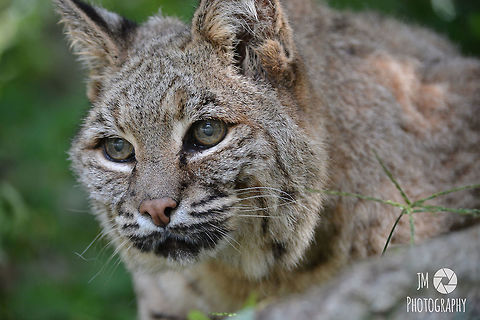
Reproduction
The average bobcat lifespan is 7 years long and rarely exceeds 10 years. The oldest wild bobcat on record was 16 years old, and the oldest captive bobcat lived to be 32.Bobcats generally begin breeding by their second summer, though females may start as early as their first year. Sperm production begins each year by September or October, and the male is fertile into the summer. A dominant male travels with a female and mates with her several times, generally from winter until early spring; this varies by location, but most mating takes place during February and March. The pair may undertake a number of different behaviors, including bumping, chasing, and ambushing. Other males may be in attendance, but remain uninvolved. Once the male recognizes the female is receptive, he grasps her in the typical felid neck grip and mates with her. The female may later go on to mate with other males, and males generally mate with several females. During courtship, the otherwise silent bobcat may let out loud screams, hisses, or other sounds. Research in Texas has suggested establishing a home range is necessary for breeding; studied animals with no set range had no identified offspring. The female has an estrous cycle of 44 days, with the estrus lasting five to ten days. Bobcats remain reproductively active throughout their lives.
The female raises the young alone. One to six, but usually two to four, kittens are born in April or May, after roughly 60 to 70 days of gestation. Sometimes, a second litter is born as late as September. The female generally gives birth in an enclosed space, usually a small cave or hollow log. The young open their eyes by the ninth or tenth day. They start exploring their surroundings at four weeks and are weaned at about two months. Within three to five months, they begin to travel with their mother. They hunt by themselves by fall of their first year, and usually disperse shortly thereafter. In Michigan, however, they have been observed staying with their mother as late as the next spring.
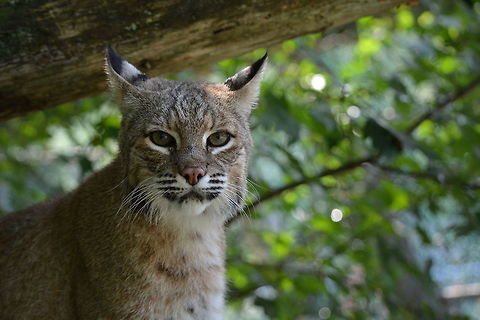
Food
The bobcat is able to survive for long periods without food, but eats heavily when prey is abundant. During lean periods, it often preys on larger animals, which it can kill and return to feed on later. The bobcat hunts by stalking its prey and then ambushing with a short chase or pounce. Its preference is for mammals weighing about 1.5 to 12.5 lb. Its main prey varies by region. In the eastern United States, it is the eastern cottontail species, and in the north it is the snowshoe hare. When these prey species exist together, as in New England, they are the primary food sources of the bobcat. In the far south, the rabbits and hares are sometimes replaced by cotton rats as the primary food source. Birds up to the size of an adult swan are also taken in ambushes, along with their fledglings and eggs. The bobcat is an opportunistic predator that, unlike the more specialized Canada lynx, readily varies its prey selection. Diet diversification positively correlates to a decline in numbers of the bobcat's principal prey; the abundance of its main prey species is the main determinant of overall diet.The bobcat hunts animals of different sizes, and adjusts its hunting techniques accordingly. With small animals, such as rodents, birds, fish including small sharks, and insects, it hunts in areas known to be abundant in prey, and will lie, crouch, or stand, and wait for victims to wander close. It then pounces, grabbing its prey with its sharp, retractable claws. For slightly larger animals, such as geese, rabbits, and hares, it stalks from cover and waits until prey comes within 20 to 35 ft before rushing in to attack. Less commonly, it feeds on larger animals, such as young ungulates, and other carnivores, such as fishers, foxes, minks, martens, skunks, small dogs, and domesticated cats. Bobcats are considered the major predatory threat to the endangered whooping crane. Bobcats are also occasional hunters of livestock and poultry. While larger species, such as cattle and horses, are not known to be attacked, bobcats do present a threat to smaller ruminants, such as sheep and goats. According to the National Agricultural Statistics Service, bobcats killed 11,100 sheep in 2004, comprising 4.9% of all sheep predator deaths. However, some amount of bobcat predation may be misidentified, as bobcats have been known to scavenge on the remains of livestock kills by other animals.
It has been known to kill deer, especially in winter when smaller prey is scarce, or when deer populations become more abundant. One study in the Everglades showed a large majority of kills were fawns, but prey up to eight times the bobcat's weight could be successfully taken. It stalks the deer, often when the deer is lying down, then rushes in and grabs it by the neck before biting the throat, base of the skull, or chest. On the rare occasions a bobcat kills a deer, it eats its fill and then buries the carcass under snow or leaves, often returning to it several times to feed.
The bobcat prey base overlaps with that of other midsized predators of a similar ecological niche. Research in Maine has shown little evidence of competitive relationships between the bobcat and coyote or red fox; separation distances and territory overlap appeared random among simultaneously monitored animals. However, other studies have found bobcat populations may decrease in areas with high coyote populations, with the more social inclination of the canid giving them a possible competitive advantage. With the Canada lynx, however, the interspecific relationship affects distribution patterns; competitive exclusion by the bobcat is likely to have prevented any further southward expansion of the range of its felid relative.
References:
Some text fragments are auto parsed from Wikipedia.